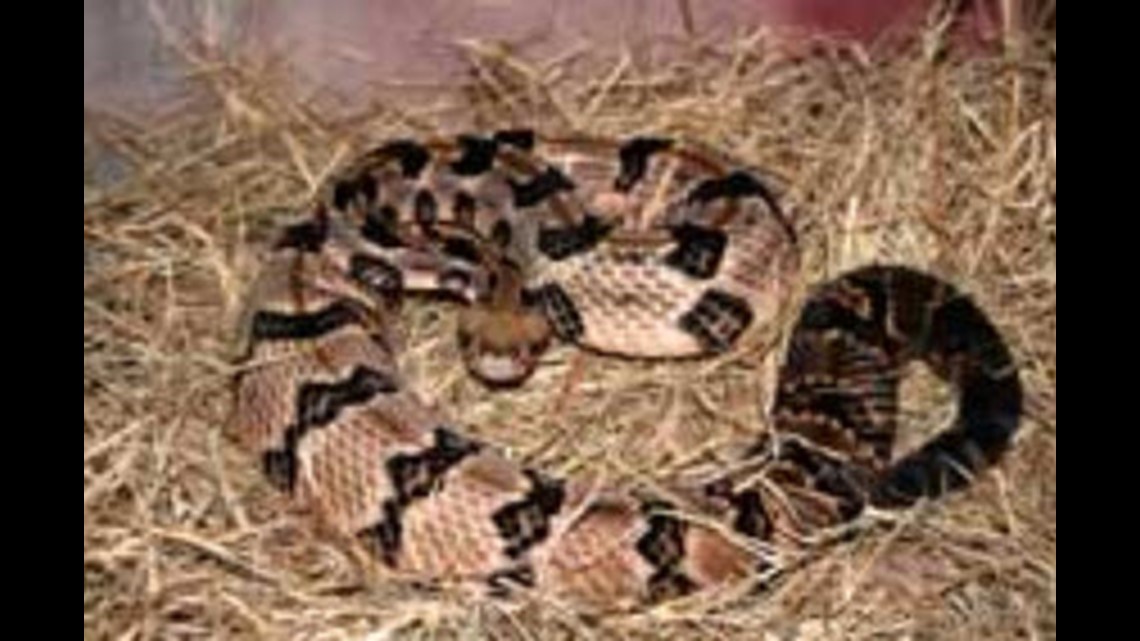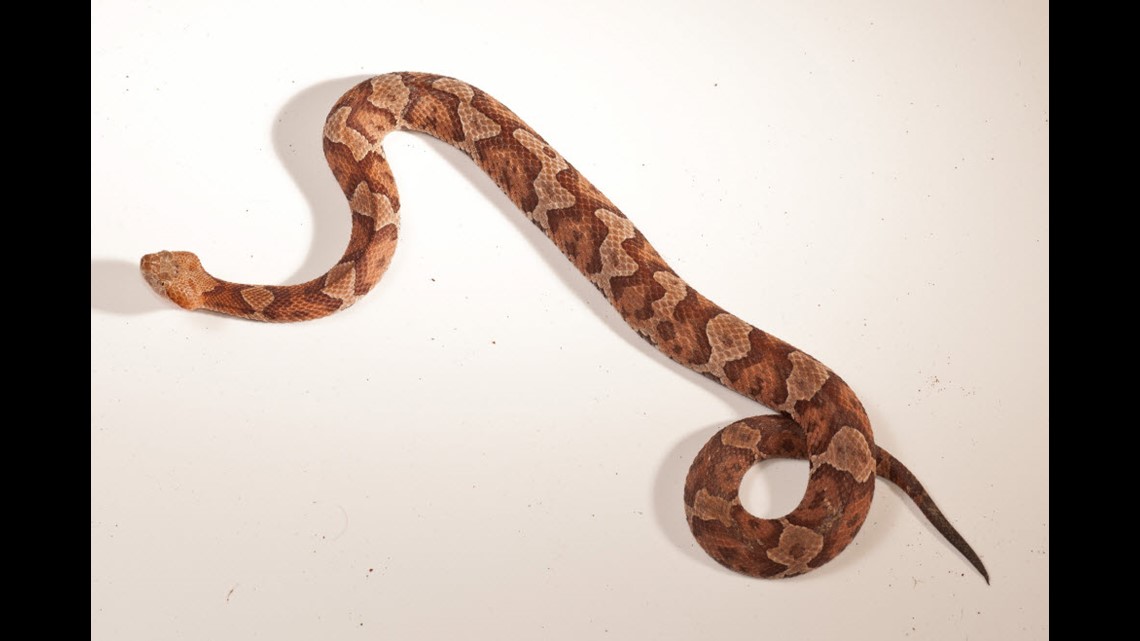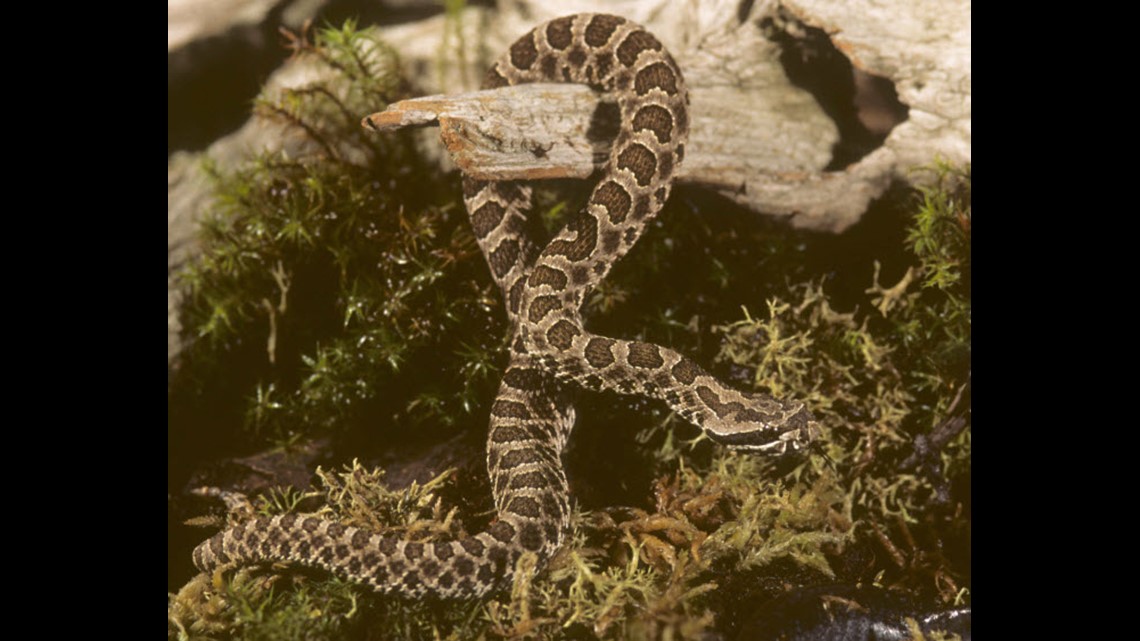If you're afraid of snakes, winter is definitely your season.
Snakes hibernate in the winter so you don't have to worry about running into them then, but the spring and summer months are when you'll want to watch out for them.
And according to pest experts, wet weather is when snakes really thrive. So, like now.
Ohio has a variety of venomous and non-venomous snakes; fortunately, there are only three venomous ones to worry about. The two the can be found in northwest Ohio are both listed as endangered species.
Ohio venomous snakes:
Eastern timber rattlesnake - The Ohio Department of Natural Resources says because of their size, the timber rattlesnake is the most dangerous snake in northeastern America. However, the snake is listed as an endangered species and is known from only seven Ohio counties. ODNR also says the snakes are mild and make little attempt to rattle or strike unless distressed. Timber rattlesnakes can grow to be six feet long, but average three to four feet long. Their rattles have two color phases: yellow and black. The yellow phase has a series of dark brown or black chevron-shaped crossbands on a ground color of brownish yellow. The black phase has the crossbands on a ground color of blackish brown.
The timber rattlesnake can be found in northwest Ohio.


Northern copperhead - The snake is named for its reddish or copper-colored head. The rest of the snake is a different color, a pinkish to gray-brown with a dark chestnut-colored hourglass pattern on its body. The copperhead is usually two to three feet long. This is also the only venomous snake in Ohio that does not have a rattle.
Although it's name says northern, it doesn't reach any counties up here in northwest Ohio.


Eastern massasauga rattlesnake - ODNR says these snakes are also endangered and becoming more and more rare in North America. They are have been recorded in as many as 22 Ohio counties. It is described as a medium-sized, dark-colored snake with 29 to 50 dorsal spots on it's body, which is gray or brownish-gray. This rattlesnake can be 14 to 25 inches long.
This snake is found in northwest Ohio.


Note: Ohio History Central says people claim to see the dangerous water moccasin, also known as a the cottonmouth, in Ohio's waters. The snake they are actually seeing is the Northern water snake, which is harmless. Water moccasins are found in the southeastern United States.
If you're not sure if a snake you have encountered is poisonous or not, look for these things. These are traits for venomous snakes in Ohio and other northeastern states only:
- There are heat sensitive pits located on the head between the nostrils and eyes (nonvenomous - have nostrils only)
- The pupils are oval (nonvenomous - round)
- The head is triangular (nonvenomous snakes have a usually oval head)
- From the vent (rectum) to the end of the tail, on the underside of the snake, the scales are not divided (nonvenomous - the scales in the same area are divided)
- Except for the copperhead, there is a rattle at the end of the tail. (Nonvenomous snakes may vibrate their tail when threatened, but do not have a rattle).
However, Ohio History Central says if you can notice these traits on a snake you come across, you're probably way too close.
There are 23 other types of snakes that also inhabit Ohio that are non-venomous - a majority of which can be found in northwest Ohio.
Ohio non-venomous snakes:
- Queensnake - found in Northwest Ohio. Status - Species of concern
- Kirtland's snake - found in Northwest Ohio. Status - Threatened
- Northern water snake - found in Northwest Ohio. Status - Common
- Lake Erie water snake - found in Northwest Ohio. Status - Common
- Copper-bellied water snake - found in Northwest Ohio. Status - Endangered.
- Dekay's brow snake - found in Northwest Ohio. Status - Common
- Red-bellied snake - found in Northwest Ohio. Status - Uncommon
- Eastern hog-nosed snake - found in Northwest Ohio. Status - Species of concern
- Eastern smooth earth snake - not found in Northwest Ohio. Status - Species of concern
- Northern ring-necked snake - found in Northwest Ohio. Status - Common
- Common wormsnake - not found in Northwest Ohio. Status - Uncommon
- North American racer - found in Northwest Ohio. Status - Common
- Gray (black) rat snake - found in Northwest Ohio. Status - Common
- Eastern fox snake - found in Northwest Ohio. Status - Species of concern
- Eastern black king snake - not found in Northwest Ohio. Status - Species of concern
- Eastern milk snake - found in Northwest Ohio. Status - Common
- Eastern garter snake - found in Northwest Ohio. Status - Common
- Plains garter snake - not found in Northwest Ohio. Status - Endangered
- Butler's garter snake - found in Northwest Ohio. Status - Uncommon
- Short-headed garter snake - not found in Northwest Ohio. Status - Species of concern
- Eastern ribbon snake - found in Northwest Ohio. Status - Uncommon
- Northern rough green snake - not found in Northwest Ohio. Status - Species of concern
- Smooth green snake - not found in Northwest Ohio. Status - Endangered
Read more and see pictures of Ohio's snakes on the Ohio DNR website.
If you're worried about running into any snakes, venomous or not, remember that snakes are more defensive than aggressive.
According to Ohio History Central, snakes will make every attempt to get away from a potential threat (that means you) before they resort to striking or biting you.
Follow these tips from the U.S. Forest Service to minimize your chances of running into snakes in the wild:
How to avoid snakes/snake bites:
- Leave snakes alone. Do not handle, tease or harass them.
- Keep a distance of at least six feet between you and the snake.
- Stay on trails and watch where you place your hands and feet, especially when climbing or stepping over fences, large rocks and logs or when collecting firewood.
- Stay away from tall grass and piles of leaves.
- Avoid climbing on rocks or piles of wood where a snake may be hiding.
- Wear long pants and proper foot gear, especially at night.
Running into any of the three venomous snakes might be scary - and, according to Ohio History Central, 8,000 people are bitten by venomous snakes in the US each year.
However, only about 9 to 15 of these people actually die from the snake bite.
Ohio History Central says more people are struck and killed by lightning each year; but if that doesn't make you feel better, here are the symptoms of and how to treat snake bites if you encounter a venomous one, according to the U.S. Forest Service.
Symptoms of a snake bite:
- A pair of puncture marks at the wound
- Redness and swelling around the bite
- Severe pain at the site of the bite
- Nausea and vomiting
- Labored breathing (in extreme cases, breathing may stop altogether)
- Disturbed vision
- Increased salivation and sweating
- Numbness or tingling around your face and/or limbs
How to treat snake bites:
- Call 911 and seek medical attention immediately.
- Keep the snake bite victim still, as movement helps the venom spread through the body.
- Keep the injured body part motionless and just lower than heart level.
- Keep the victim warm, calm and at rest.
- Do not allow the person to eat or drink anything.
- Cover the bite with a clean, dry dressing.
You might have heard of some other ways to treat snake bites, like these seven below. The U.S. Forest service says contrary to popular belief, these are not ways to treat them.
How NOT to treat snake bites:
- Wait for symptoms to appear if bitten, seek immediate medical attention.
- Apply a tourniquet.
- Slash the wound with a knife.
- Suck out the venom.
- Apply ice or immerse the wound in water.
- Drink alcohol as a painkiller.
- Drink caffeinated beverages.


